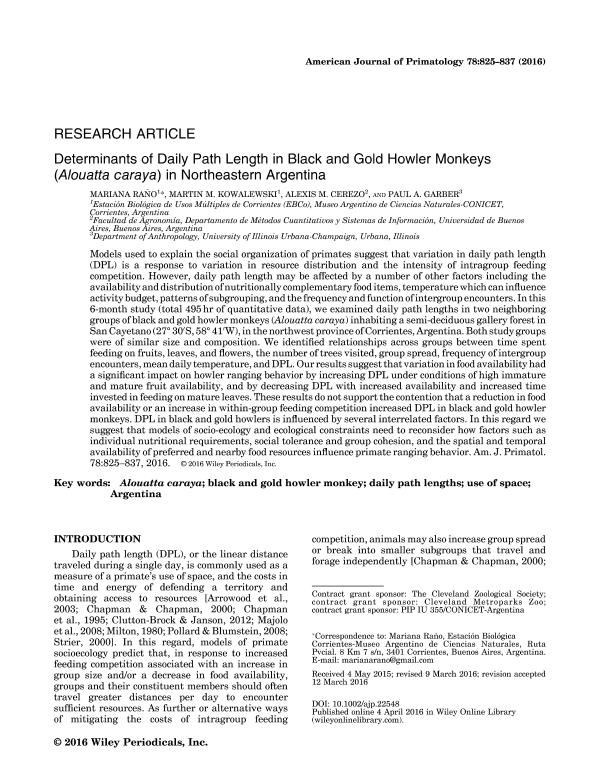Mostrar el registro sencillo del ítem
dc.contributor.author
Raño, Mariana
dc.contributor.author
Kowalewski, Miguel Martin

dc.contributor.author
Cerezo, Alexis M.
dc.contributor.author
Garber, Paul A.
dc.date.available
2018-07-02T20:27:53Z
dc.date.issued
2016-08
dc.identifier.citation
Raño, Mariana; Kowalewski, Miguel Martin; Cerezo, Alexis M.; Garber, Paul A.; Determinants of daily path length in black and gold howler monkeys (Alouatta caraya) in northeastern Argentina; Wiley-liss, Div John Wiley & Sons Inc; American Journal Of Primatology; 78; 8; 8-2016; 825-837
dc.identifier.issn
0275-2565
dc.identifier.uri
http://hdl.handle.net/11336/50941
dc.description.abstract
Models used to explain the social organization of primates suggest that variation in daily path length (DPL) is a response to variation in resource distribution and the intensity of intragroup feeding competition. However, daily path length may be affected by a number of other factors including the availability and distribution of nutritionally complementary food items, temperature which can influence activity budget, patterns of subgrouping, and the frequency and function of intergroup encounters. In this 6-month study (total 495 hr of quantitative data), we examined daily path lengths in two neighboring groups of black and gold howler monkeys (Alouatta caraya) inhabiting a semi-deciduous gallery forest in San Cayetano (27° 30'S, 58° 41'W), in the northwest province of Corrientes, Argentina. Both study groups were of similar size and composition. We identified relationships across groups between time spent feeding on fruits, leaves, and flowers, the number of trees visited, group spread, frequency of intergroup encounters, mean daily temperature, and DPL. Our results suggest that variation in food availability had a significant impact on howler ranging behavior by increasing DPL under conditions of high immature and mature fruit availability, and by decreasing DPL with increased availability and increased time invested in feeding on mature leaves. These results do not support the contention that a reduction in food availability or an increase in within-group feeding competition increased DPL in black and gold howler monkeys. DPL in black and gold howlers is influenced by several interrelated factors. In this regard we suggest that models of socio-ecology and ecological constraints need to reconsider how factors such as individual nutritional requirements, social tolerance and group cohesion, and the spatial and temporal availability of preferred and nearby food resources influence primate ranging behavior. Am. J. Primatol. 78:825-837, 2016. © 2016 Wiley Periodicals, Inc.
dc.format
application/pdf
dc.language.iso
eng
dc.publisher
Wiley-liss, Div John Wiley & Sons Inc

dc.rights
info:eu-repo/semantics/openAccess
dc.rights.uri
https://creativecommons.org/licenses/by-nc-sa/2.5/ar/
dc.subject
Alouatta Caraya
dc.subject
Argentina
dc.subject
Black And Gold Howler Monkey
dc.subject
Daily Path Lengths
dc.subject
Use of Space
dc.subject.classification
Otras Ciencias Biológicas

dc.subject.classification
Ciencias Biológicas

dc.subject.classification
CIENCIAS NATURALES Y EXACTAS

dc.title
Determinants of daily path length in black and gold howler monkeys (Alouatta caraya) in northeastern Argentina
dc.type
info:eu-repo/semantics/article
dc.type
info:ar-repo/semantics/artículo
dc.type
info:eu-repo/semantics/publishedVersion
dc.date.updated
2018-06-22T14:33:16Z
dc.identifier.eissn
1098-2345
dc.journal.volume
78
dc.journal.number
8
dc.journal.pagination
825-837
dc.journal.pais
Estados Unidos

dc.journal.ciudad
Nueva York
dc.description.fil
Fil: Raño, Mariana. Consejo Nacional de Investigaciones Científicas y Técnicas. Oficina de Coordinación Administrativa Parque Centenario. Museo Argentino de Ciencias Naturales “Bernardino Rivadavia”; Argentina
dc.description.fil
Fil: Kowalewski, Miguel Martin. Consejo Nacional de Investigaciones Científicas y Técnicas. Oficina de Coordinación Administrativa Parque Centenario. Museo Argentino de Ciencias Naturales “Bernardino Rivadavia”; Argentina
dc.description.fil
Fil: Cerezo, Alexis M.. Universidad de Buenos Aires. Facultad de Agronomía. Departamento de Métodos Cuantitativos y Sistemas de Información; Argentina
dc.description.fil
Fil: Garber, Paul A.. University of Illinois at Urbana; Estados Unidos
dc.journal.title
American Journal Of Primatology

dc.relation.alternativeid
info:eu-repo/semantics/altIdentifier/doi/http://dx.doi.org/10.1002/ajp.22548
dc.relation.alternativeid
info:eu-repo/semantics/altIdentifier/url/https://onlinelibrary.wiley.com/doi/abs/10.1002/ajp.22548
Archivos asociados
